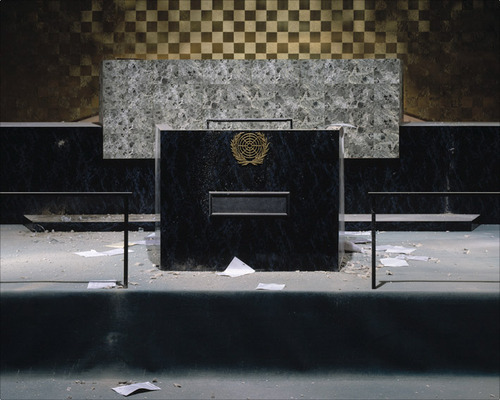
© Lieven Lefere in collaboration with Charles Verraest, ‘General Assembly’, 2008
Tell us about your approach to photography. How it all started? What are your memories of your first shots?
Lieven Lefere (LL):
I got my first camera from my grandfather who was a local photographer and the owner of a photography shop. Each grandchild got a Nikon reflex camera for their 12th birthday. I remember clearly the day it was given to me. Nowadays it is quite normal to have a mobile phone or an Ipad for young people, but back then it was something really special to have a reflex camera as a present.
My first shots were not that special. I remember loading my first film and taking my camera to the field next to the banquet hall. I shot a whole film of horses that were shitting.
How did your research evolve with respect to those early days?
LL: Considering, I’m actually grateful it didn’t!
Tell us about your educational path. What are your best memories of your studies. What was your relationship with photography at that time?
LL: As most students I was more or less searching to find my own language as a photographer and trying to overcome the formal language of the Academy. Although this went quite naturally since I wasn’t much of a talker in those days. My relationship with photography only slowly came out some years after graduating.

© Lieven Lefere, 'House 2’ (in collaboration with Charles Verraest), 2010
What were the courses that you were passionate about and which have remained meaningful for you?
LL: I remember the theoretical classes about Jean-Paul Sartre and Akira Kurosawa best since these teachers aimed to focus on one aspect of literature or film during the course of a whole semester. By this means you got the chance to learn a lot about a single body of work instead of learning little about a lot. I still carry Sartre’s idea of man as a process of becoming along in my daily life and I think it also matches with my creative development. To speak of Kurasowa; I still hear the dying main character of his movie 'Ikuru’ singing «Life is brief, fall in love, maidens…»
Any professor or teacher that has allowed you to better understand your work?
LL: I do not consider the photographs I made during my studies as a body of work so there wasn’t really something to find regarding a general meaning. But of course there were teachers that helped me better than others to point out my mistakes and direct me to an understanding of the methods that make a series of photographs consistent as a whole. I believe the best teachers were those who kept on saying «You are not there yet and clearly explaining to me why afterwards».

© Lieven Lefere, 'Bed’, 2011
What do you think about photography in the era of digital and social networking?
LL: I am not directly preoccupied with the social media tools. My favorite mistake.
About your work now. How would you describe your personal research in general?
LL: Photography is in a way always only a limited, artificial copy of reality, a simulacrum. My images expose this mechanism by being representations of representations of reality, or simulacra squared. Through this evident unmasking of the medium the question of the ‘true image’ is made explicit. It is in the abstracting reconstruction of the reconstruction, in documenting the simulation that I try to find the key to make latent aspects, such as the control apparatus present in all social layers, visible.
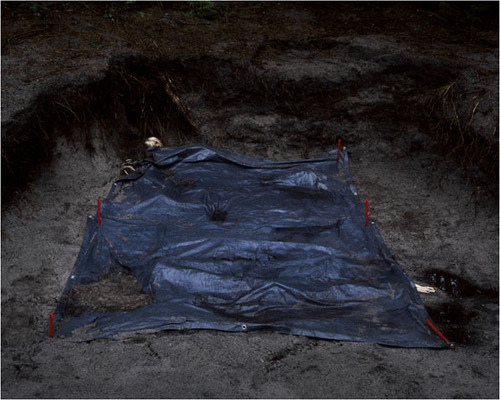
© Lieven Lefere, 'Hollow’, 2014

© Lieven Lefere, 'Man’, 2012

© Lieve Lefere, 'Road’, 2012
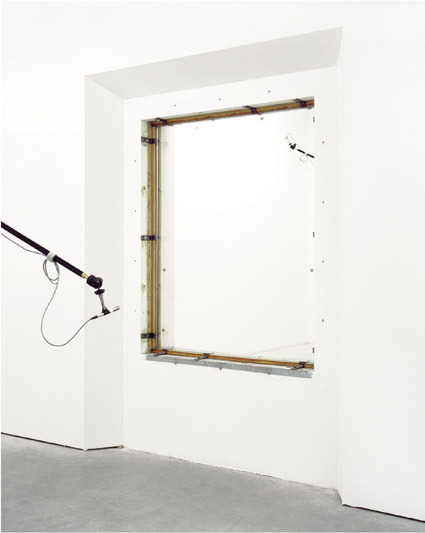
© Lieven Lefere, 'Window’, 2012
Do you have any preferences in terms of cameras and format?
LL: I usually work with a Sinar technical camera with 4-5’ transparency sheets. This kind of camera helps me to find a focus while handling the technical aspects. When I need to work faster, I work with a borrowed Canon D5 Mark II camera. Afterwards these images are adapted to a 4/5 format.
Tell us about your latest work
LL: My latest work 'A more elevated scene (looking West)’ was made for an exhibition about the sea in Ostend on the Belgian coast. This was made in the spirit of the artist residence I did at KIK in the Netherlands, which was entitled 'I Never Promised You a Horizon’. For this series I approached photography as a viewing machine with an unusual vertical frame. I have long wanted to implement different media in my practice. In the past I made photographs that were representations of scenes that I built in my studio but they were never independent sculptures. They were built to be photographed and the result were meant to end up as photographs in frames on a wall.
The work is based on the tallest apartment building of the Belgian coast constructed on the location of the former city theatre. This typical building of the seventies, standing in the second row of blocks, is facing the sea and the dawn. These kind of towers were mostly built upon an idea of Mies van der Rohe claiming that «all people had the right to see the horizon». Indeed, a very poetic idea but in this case giving the horizon to the inhabitants of the apartments meant taking it away from all people living in it’s shadow. Until the early nineties a panoramic restaurant on the top floor of the apartment block compensated for this loss of horizon partly because it was accessible to all people. After this establishment closed the building lost its public function.

© Lieven Lefere, 'A More Elevated Scene (Looking West)’, 2014, exhibtion view
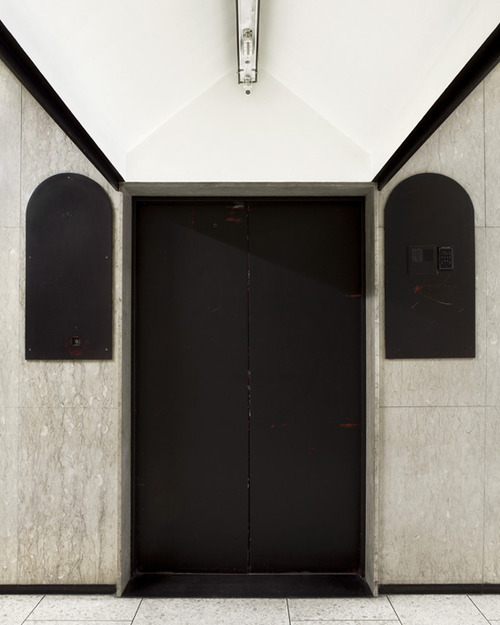
© Lieven Lefere, 'A More Elevated Scene (Looking West)’, 2014, The Promise
I made an architectural proposal in the form of a scale model to reshape the building in a public viewing machine, in an attempt to also give back the horizon as the theatre to the public. The scale model was combined with a table, two stools and three photographs that played with the notion of the horizon and were photographed in the tower. As I did for 'I Never Promised You a Horizon’ I played with the vertical as opposed to the horizontal character of the seascape by framing only a thin vertical line.
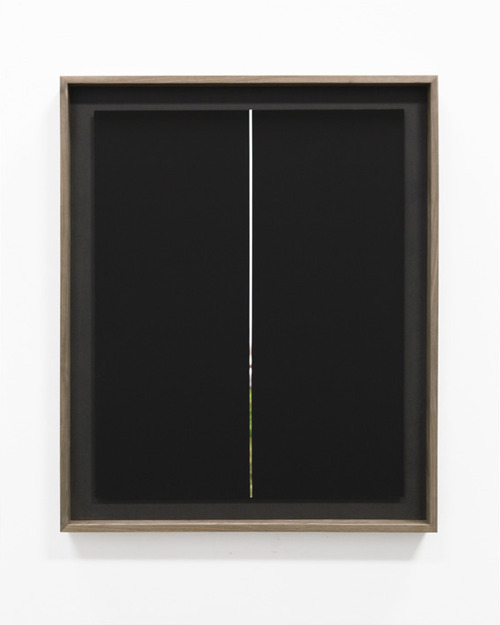
© Lieven Lefere, 'I Never Promised You a Horizon’, 2014

© Lieven Lefere, 'I Never Promised You a Horizon’, 2014, exhibition

© Lieven Lefere, 'I Never Promised You a Horizon’, 2014, inscription
Is there any contemporary artist or photographer, even if young and emerging, that influenced you in some way?
LL: I am certainly influenced by the formal language of the Belgian sculptor Jan De Cock since I was his assistant for a long time. I consider this period as a very important part of my own development as an artist and I very much believe that newly graduated art students can benefit from working some years in the studio of an international artist.

© Lieven Lefere, 'Integrety Protecting the Work of Man’, 2010
Hiroshi Sugimoto is one of the photographers I admire most for his serial approach of photography and the notion of time, the consistency of his body of work and the simplicity of his aesthetics. I refer to two of his series in my latest work 'A More Elevated Scene (looking West)’ by combining the theatre with the seacape.
The young Belgian artist Egon Van Herreweghe is inspiring for his research on the relation between the original and the copy.
Three books of photography that you recommend?
LL: - 'Relation’ by Craigie Horsfield
- 'Architecture of Time’ by Hiroshi Sugimoto
- The Atlas Group '1989-2004 A Project by Walid Raad’
Is there any show you’ve seen recently that you find inspiring?
LL: Some weeks ago in Düsseldorf I found myself shivering again in front of the 'Sterne’ series by Thomas Ruff. Intriguing to feel how a black surface with some bright dots can make you fall to the floor.

© Thomas Ruff
Projects that you are working on now and plans for the future?
LL: Currently I am working on a project about the Mausoleum of Ho-Chi-Minh in Hanoi. One of the blind spots in the world where no photographs can be taken. I will make a reconstruction of the inner space of the building by means of the testimonials by a group of Western tourists. Questioning the truth about perception, the ability to remember and the status of an image in relation to what we call reality.
---
LINKS
Lieven Lefere
Belgium
share this page
